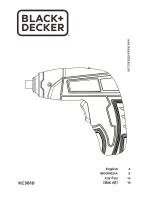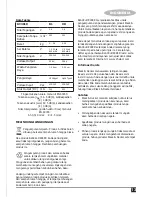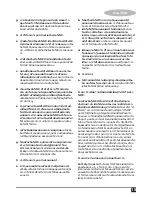
5
g. If devices are provided for the connection
of dust extraction and collection facilities,
ensure these are connected and properly
used.
Use of dust collection can reduce dust-
related.
4. Power tool use and care
a. Do not force the power tool.
Use the correct
power tool for your application.
The correct
power tool will do the job better and safer at the
rate for which it was designed.
b. Do not use the power tool if the switch
does not turn it on and off.
Any power tool
that cannot be controlled with the switch is
dangerous and must be repaired.
c. Disconnect the plug from the power source
and/or the battery pack from the power tool
before making any adjustments, changing
accessories, or storing power tools.
Such
preventive safety measures reduce the risk of
starting the power tool accidentally.
d. Store idle power tools out of the reach of
children and do not allow persons unfamiliar
with the power tool or these instructions
to operate the power tool.
Power tools are
dangerous in the hands of untrained users.
e. Maintain power tools.
Check for
misalignment or binding of moving parts,
breakage of parts and any other condition
that may affect the power tools operation.
If damaged, have the power tool repaired
before use.
Many accidents are caused by
poorly maintained power tools.
f. Keep cutting tools sharp and clean.
Properly
maintained cutting tools with sharp cutting edges
are less likely to bind and are easier to control.
g. Use the power tool, accessories and tool bits
etc. in accordance with these instructions,
taking into account the working conditions
and the work to be performed.
Use of the
power tool for operations different from those
intended could result in a hazardous situation.
5. Battery tool use and care
a.
Recharge only with the charger specified by
the manufacturer.
A charger that is suitable for
one type of battery pack may create a risk of fire
when used with another battery pack.
b.
Use power tools only with specifically
designated battery packs.
Use of any other
battery packs may create a risk of injury and fire.
c. When battery pack is not in use, keep it away
from other metal objects, like paper clips,
coins, keys, nails, screws or other small
metal objects that can make a connection
from one terminal to another.
Shorting the
battery terminals together may cause burns or
a fire.
d.
Under abusive conditions, liquid may be
ejected from the battery; avoid contact.
If
contact accidentally occurs, flush with water.
If liquid contacts eyes, additionally seek
medical help.
Liquid ejected from the battery
may cause irritation or burns.
6. Service
a. Have your power tool serviced by a
qualified repair person using only identical
replacement parts.
This will ensure that the
safety of the power tool is maintained.
SPECIAL SAFETY ADVICE FOR
SCREWDRIVER
Hold power tool by insulated gripping surfaces,
when performing an operation where the
fastener may contact hidden wiring.
Fasteners
contacting a “live” wire may make exposed metal
parts of the power tool “live” and could give the
operator an electric shock.
Only plug the Battery
Charger in correct voltage mains according to
Technical Data. Recharge the Battery only with the
provided charger.
Before starting any work on walls,
floors or similar, make sure that all power lines in the
work area are switched off at the main switchboard.
Inspect the proposed drill hole location for any
utility lines (e.g. water, gas, power) before drilling.
Use a suitable device such as a metal or electricity
line detecting device.
If in doubt contact a qualified
electrician or your utility provider.
Both tools and
work-pieces can heat up considerably during the
drilling operation.
Allow a sufficient period of cooling
before handling.
Wear appropriate gloves.






































